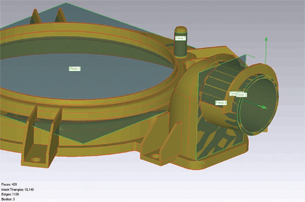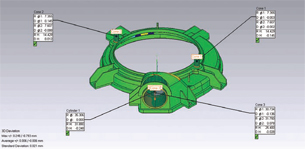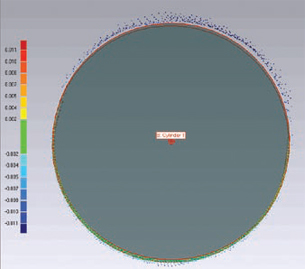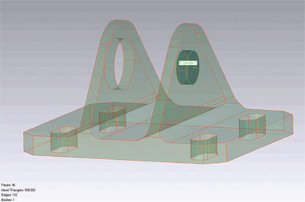Geomagic Qualify Enables Review of Real-World Functionality, 1 in a Series
Operational analysis using Geomagic software helps Schneider-Electric take a "quantum leap."
Latest News
February 2, 2009
By Bob Cramblitt
 Schneider-Electric uses Geomagic Qualify 10 to quickly detect, create, and inspect geometricfeatures in a host of solutions designed for electrical utilities and other industries. |
Page 1 | 2 »
Although he’s not one for clichés, Rus Emerick, process improvement specialist at Schneider-Electric, endorses this one: “The whole is greater than the sum of its parts.”
This concept, which dates back to Aristotle, is at the core of an approach called functional analysis that has implications throughout Schneider-Electric, a company with nearly 90,000 employees in 130 countries. The company offers processes control, power supply, distribution, and energy monitoring solutions for electrical utilities, water and waste treatment plants, public-sector investors, and other industries.
According to Emerick, functional analysis at Schneider-Electric took a “quantum leap” with the new feature inspection capabilities introduced in Geomagic Qualify 10 software. The software enables users to quickly detect, create, and inspect geometrical features for tasks such as calculating size, analyzing fit, comparing 2D and 3D features, and measuring point-to-point and feature-to-feature distances and angles.
 Geomagic Qualify 10 enables automatic feature creation and inspection tasks like calculating size,analyzing fit, comparing 2D and 3D features, and measuring point-to-point distances and angles. |
“Instead of looking at dimensions of individual parts, we are now able to analyze functionality as a major element of an entire assembly’s analysis,” says Emerick. “We simulate how parts exist in the real world, especially how they relate to their mating parts. We’ve saved a lot of time and material by validating our predicted functional conditions.”
Out of Theoretical, Into Real
Emerick uses a hole and a pin as an example of how functional analysis works. It is difficult and time-consuming to measure all possible cross-sections of the hole, and the 2D measurements often don’t have a close relationship to the fit of a cylinder into the hole. The hole also might be constrained in its x,y location relative to another location, which might restrain the possible size of an inserted pin.
 Feature inspection in Qualify 10 acts as a virtual pin gauge, describing the wall location and recalculating the largest diameter of a pin that will fit in the hole.Image courtesy of Schneider-Electric |
Feature inspection in Geomagic Qualify 10 acts as a virtual pin gauge, describing the wall location and recalculating the largest possible diameter of a pin that will fit in the hole, all the while maintaining the original constraints. This gives users insight into the behavior and fit of a functional cylindrical feature rather than just the center location.
“It’s like when you go to Dunkin’ Donuts,” says Emerick. “You’re not interested in the hole, but what surrounds the hole; it’s the same thing with a part within an assembly. It’s not the center of the hole, but the contact location that determines whether it will function with other parts as it is intended. The ability to analyze fit takes contact datum out of the theoretical world into the real world.”
A surprising advantage of being able to analyze based on function is that many more parts can be accepted without compromising standards. That’s because an assembly often functions like a team, with the whole working together to overcome individual weaknesses.
“In many cases when individual parts are measured, they fail to meet tolerances,” says Emerick. “But an assembly can distribute tolerances throughout the chain of individual parts, and the assembly meets Six Sigma standards. This has tremendous cost and material implications.”
A Positive Pyramid
Thanks to company-wide adoption of digital shape sampling and processing (DSSP), functional analysis has permutations throughout Schneider-Electric. It drives a philosophy that Emerick calls “design anywhere, build anywhere, qualify anywhere.”
 Geomagic Qualify 10 shows the intended pin diameter from the original CAD model.Image courtesy of Schneider-Electric |
DSSP describes the use of 3D scanning technologies to close the loop between physical products and their digital representations. The key DSSP component for Schneider-Electric is Geomagic software, both Geomagic Qualify for quality inspection and Geomagic Studio for digital reconstruction.
Implementation of DSSP within Schneider-Electric works a bit like a well-functioning pyramid scheme. Approximately 50 “superusers” in seven regional centers — two in the US. (Cedar Rapids, IA, and Columbia, MO), two in France (Grenoble and Angouleme), two in Shanghai, and one in Bangalore, India — head up training and implementation of Geomagic software. The superusers combine an in-depth knowledge of Geomagic software with old-school inspection skills.
Page 1 | 2 »
Subscribe to our FREE magazine, FREE email newsletters or both!
Latest News
About the Author
DE’s editors contribute news and new product announcements to Digital Engineering.
Press releases may be sent to them via [email protected].






